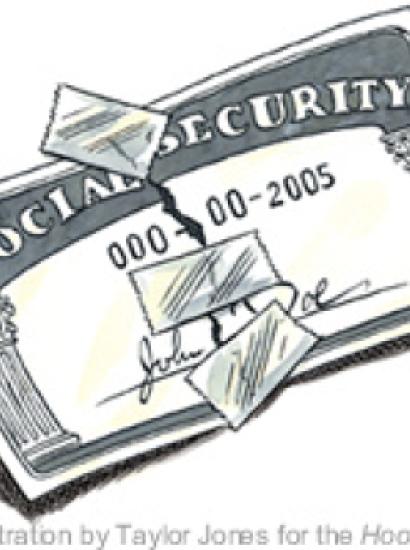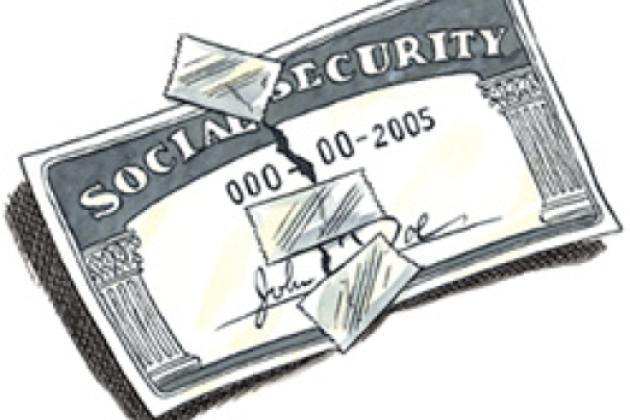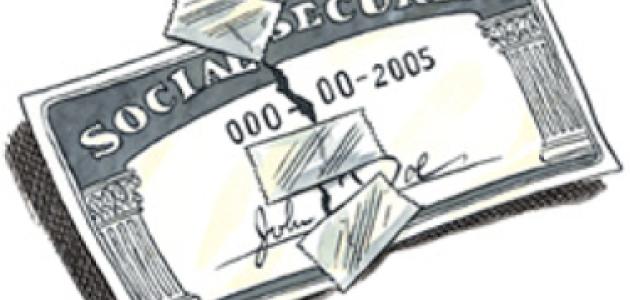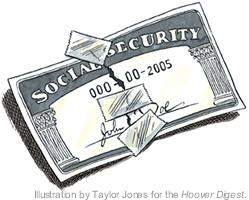- Budget & Spending
- Economics

Americans are now enjoying the fruits of two centuries of individual liberty and free markets. Our standard of living is the highest in the world, unemployment is low, productivity is up, and no significant inflation looms on the horizon. The most serious, knowable threat to continued prosperity is the rising costs of federal entitlements. Unless Social Security, Medicare, and Medicaid are reformed, the federal government’s claim on the nation’s economic resources will rise permanently to about 35 percent of GDP, a peacetime level unprecedented in our nation’s history. Financing this level of government with tax increases will create an economy that looks a lot less like the dynamic free market we enjoy today and a lot more like the sluggish, statist economies of Europe’s welfare states, with their lower living standards and chronically high unemployment.
President Bush has wisely chosen to address Social Security first. Although health-care entitlements account for a larger share of projected federal spending growth, there is a far greater consensus among policymakers on how to fix Social Security.
President Bush’s plan to allow workers voluntarily to divert a portion of their payroll taxes into personal retirement accounts will give a generation of young workers a new opportunity to achieve higher wealth, greater financial security, and more control over their retirement years. His plan for personal retirement accounts is also an essential ingredient in any plan to fix Social Security’s financial problem.
President Bush’s proposal places a simple choice before Congress and the public. Should we continue Social Security as a pay-as-you-go program? Or should we instead create a more modern Social Security system that both saves and invests?
Both saving and investment are fundamental to any viable public or private retirement program. Only by withholding income from current consumption can it be made available for future consumption. Only by investing that income wisely can we capture the powers of compound returns that enable wealth creation.
However, the Social Security program neither saves nor invests. The federal government does not set aside surplus payroll taxes for the future. It does not use the surplus funds to lessen the national debt burden on future generations. Instead, driven by chronic election-year-induced myopia, elected officials regularly spend Social Security surpluses on expanded general government activities. This fact bears repeating: Whenever the Social Security program has more money coming in than it is required to pay out, the federal government spends the surplus.
This behavior is neither new nor unique to the current Congress. During the 1950s, 1960s, and early 1970s, surplus payroll taxes were used to finance benefit increases. Since the 1980s, surplus payroll taxes have been used to finance expansions in government activities unrelated to Social Security. The fact that Treasury bills representing surplus revenues are printed up in Parkersburg, West Virginia, and placed in a “trust fund” does not mean that the government has created a financial asset. Instead, it signifies only that the government has counted the money twice: once as an additional outlay and once as an addition to Social Security’s assets—a financial “two-fer” that would be illegal if used by a private corporation.
President Bush’s proposal is the only sound way to ensure that current surplus payroll taxes aren’t spent but instead are set aside and saved. The accounts would be workers’ private property to be used exclusively to provide for their own retirement income. Ownership and control over the accounts would reside with workers, not the government.
The president’s personal account plan is not a radical or new idea. In the past 25 years, countries as diverse as Australia, Chile, Great Britain, and Sweden have adopted similar personal account plans for their retirement systems. In each case, these countries’ leaders addressed the question of whether it is best to have a Social Security system based on genuine savings and investment or a program that is pay-as-you-go. In each case, they chose savings and investment.
One other way to make sure the Social Security surpluses are saved, not spent, is for the federal government itself to invest the surpluses in stocks and bonds. This proposal is now being championed by AARP and others. (I’ll leave it to AARP’s leaders to explain why they believe the federal government is a more capable investor than their own members.) My own objection is that government investment inevitably leads to social investing, crony capitalism, government interference in corporate governance matters, and, eventually, government ownership of the means of production. There’s a word for that, of course: socialism. A century of experience has shown it doesn’t work. For good reasons then, government investment in corporate equities was rejected by President Roosevelt and every president since who has considered it, including President Bush.
Why institute personal retirement accounts now? During the next 10 years, Social Security tax revenue is projected to exceed benefit payments by more than $100 billion a year. Enacting President Bush’s proposal will ensure that the lion’s share of those funds, raised in the name of retirement, is actually used to fund retirement benefits, not spent instead. Failure to enact the president’s plan would mean that payroll tax surpluses will be frittered away on a myriad of wasteful government programs that have been funded solely because surplus Social Security tax revenues have been available to finance them.
President Bush’s proposal would, of course, mean less money for the U.S. Treasury in the near term. Critics have decried this outcome, saying it would raise the government’s annual deficit. Under the president’s plan, workers who opt for personal accounts would, upon retirement, receive reduced payroll-tax-financed Social Security benefits. Lowered benefits are only reasonable because such workers will contribute less to the traditional Social Security program and because the higher returns on personal account investments will more than offset the reductions. More important, over the long term, personal account investment income would replace tax-financed benefits. Government Social Security liabilities would decline, thereby lessening the tax burden on future generations.
As a result, the federal government’s indebtedness, honestly measured, will not increase. Instead, future governmental liabilities that do not now appear in the federal budget will be shifted earlier in time and recognized on the budget books today.
Recognition of this liability will have a salutary fiscal impact, forcing Congress to discipline itself by curtailing federal spending growth. Having less money available and initially facing higher deficits, Congress, like all other legislative bodies in similar circumstances, will exercise greater spending restraint. Programs that have in recent years received greater funding simply because surplus payroll taxes have been available will be pared back. The job of restraining government spending is never easy, but under the president’s plan, Congress need only pare about 5 percent a year from government spending to fully ensure that personal accounts lead to higher national savings.
Personal retirement accounts, as the president has often said, will not by themselves fix Social Security’s financial shortfall. Congress must take additional action to bring promised benefits in line with Social Security revenues. But personal accounts are an essential part of any fix.
















